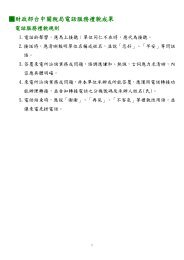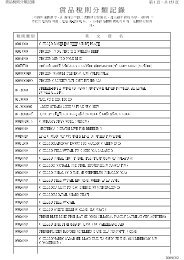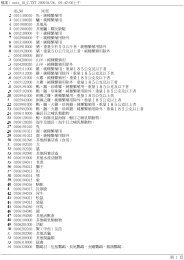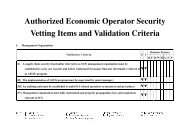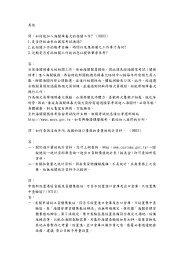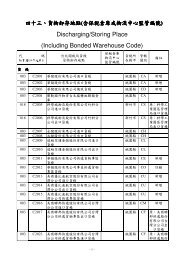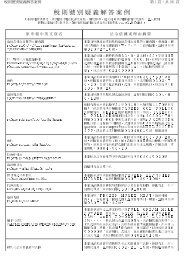Stories of Taiwan (Ecology)
Stories of Taiwan (Ecology)
Stories of Taiwan (Ecology)
You also want an ePaper? Increase the reach of your titles
YUMPU automatically turns print PDFs into web optimized ePapers that Google loves.
<strong>Stories</strong> <strong>of</strong> <strong>Taiwan</strong> (<strong>Ecology</strong>)(a small place with enormous potential, and a place where history and modernismcoexist.)1. Are you looking at me?In <strong>Taiwan</strong>, there are lots to see just around us while we don’t usually give them aglance. Believe it or not, let me give you some examples:Tree fern:For example, Cyathea lepifera (J. Sm.) Copell, a plant can be traced back tothe Jurassic Period beginning 200 million years ago.Miscanthus floridulus:A vital plant <strong>of</strong> great traction which can grow on either moistsoil or dry soil, so it’s hard to dig it out. One German expert regarded it asthe treasure <strong>of</strong> <strong>Taiwan</strong>.Acacia confusa Merr:One <strong>of</strong> the tree species that is fast-growing, solid, burnable, andun-yielding in the rain. It is perfect for soil and water conservation, and itgrows almost everywhere. It used to be the beams in mining shafts because<strong>of</strong> its toughness. In <strong>Taiwan</strong>, Acacia confusa Merr, can even grow fromconcrete walls. It was largely imported to Yangtze River Basin and HongKong for soil and water conservation.tree fern Miscanthus floridulus Acacia confusa Merr insectsNote: <strong>Taiwan</strong> is a kingdom <strong>of</strong> tree fern, insects, and butterflies.2. Age:<strong>Taiwan</strong> was formed around 20 million years ago, while Kinmen was around 200million years and the Earth was around 4 billion years ago. (<strong>Taiwan</strong> was compressedand shifted dramatically from the sea by the force <strong>of</strong> the Philippine Sea tectonic platecrashing into the Eurasian plate 20 million years ago.)3. The last Ice Age started about 18,000 to 10,000 years ago and lasted for thousand years.The low sea level caused the land below the <strong>Taiwan</strong> straits to emerge, forming a landbridge between <strong>Taiwan</strong> and the mainland. The Ice age caused coniferous forests tomove from 50° to 21° N latitude. When the ice age ended, the sea level increased t<strong>of</strong>orm the <strong>Taiwan</strong> Straits, cutting <strong>of</strong>f the route between the two landmasses and makingthese coniferous forests stay. Due to the global warming, the coniferous forests movedto high mountains, contributing a great diversity <strong>of</strong> vegetation in <strong>Taiwan</strong>. Tropicalplants and cold plants distributed vertically according to the elevation. After along-term evolution, some plants became endemic species in <strong>Taiwan</strong>.4. The Alps in Europe stretches from east to west, stopping the species to migrate fromnorth to south, so it presents simple species. The species in Central Mountain aresimilar to those in East Himalayas. Mountains stretching from south to north allowspecies to display variously.5. The areas where the Ice Age affected the least is the triangular zone surrounded by theEast Himalayas, <strong>Taiwan</strong>, and Japan. <strong>Taiwan</strong> is exactly located between 20° and 30° Nlatitude, in the Ice Age serving a Refuge that got those high-altitude plants such asginkgo biloba, Chamaecyparis Formosensis Matsum, <strong>Taiwan</strong>ia cryptomerioides(endemic in <strong>Taiwan</strong>) and so forth to grow in <strong>Taiwan</strong>. Other places locate in the samealtitude (20°-30°) such as Desert Sahara in Africa, Saudi in Mid East, and NorthMexico in America are deserts. <strong>Taiwan</strong> owes it to the marine climate and highmountains covered with a sea <strong>of</strong> clouds.6. Stones are invisible at the point <strong>of</strong> 4,000 kilometers away from the estuary <strong>of</strong> theAmazon River in South America, and are those in the Mississippi River. Because two
ivers mentioned above are long and flat, heavier stones are left upriver. In <strong>Taiwan</strong>,cliffy mountains make rivers short and steep with rapid flows, so there are stoneseverywhere in the estuary. (It’s quite interesting, isn’t it?)7. <strong>Taiwan</strong> is a small place with enormous potential, and a place where history andmodernism coexist. Although it only has 20 million years <strong>of</strong> history, creatures that dateback to 65 million years ago still exist there. There are no coniferous forests on anyPacific Islands in the world, from South East Asia to Hawaii, except for <strong>Taiwan</strong>. Pines,firs, and cypresses grow in 50° N latitude, forming the so-called the Black Forests.Those tree species are unique in the Northern Hemisphere. The southernmost areathey survive in is <strong>Taiwan</strong>, and you can’t see any <strong>of</strong> them in the Southern Hemisphere.Tropical plants exist between the equator and <strong>Taiwan</strong>. For example, the Red Forestsare mostly located on South East, six types <strong>of</strong> them can be found in Kaohsiung, butonly one in Taipei (the northernmost latitude in the whole world). The Black Forest in<strong>Taiwan</strong> is the most ancient one on earth. Cunninghamia lanceolata and <strong>Taiwan</strong>iacryptomerioides around 30 million years old, exist just next to the East-West CrossIsland Highway.8. Do you love me? Formosa! Formosa, the island <strong>of</strong> beauty, I love you.(Shared by WU, Hong-Chih, Translated by LO, Yah-Lan)



